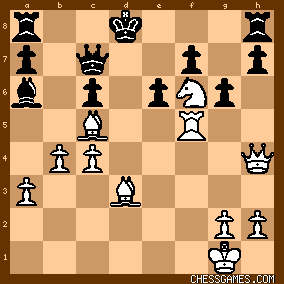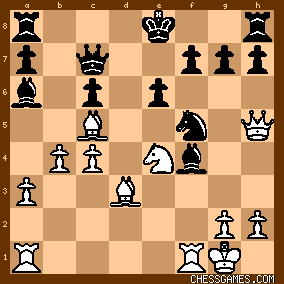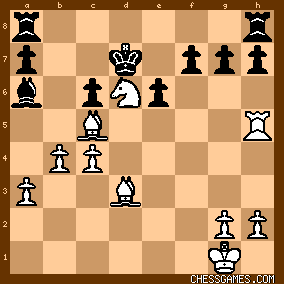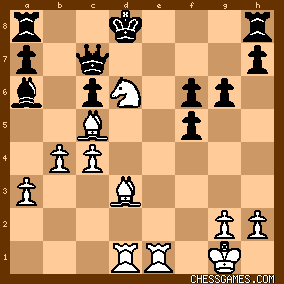|
< Earlier Kibitzing · PAGE 2 OF 2 ·
Later Kibitzing> |
| Feb-08-13 | | Abdel Irada: This puzzle hides many parts, and I haven't the energy at present to examine them all. The key move doesn't require more than a few trivial failed alternatives to confirm: Either 28. Rxf4 wins, or this is a spoiler. But what happens after this is, in fact, fairly complex: Black can accept this sac or interpose with counterthreats; and if he does accept it, similar counterthreats still pose dilemmas; for this, I will need my Indefatigable Investigator's hat — which unfortunately grows heavy at times. One defense that doesn't seem to work, however:
<19. ...g6
20. Qxf5†!, gxf5>
This seems preferable, since Black is well advised to keep the e-file closed if possible. <21. Nd6†, Kd8>
Not good is 21. ...Kf8? 22. Nb5†  . .
An alternative is 21. ...Kd7, but this allows 22. Rd4!, when Black can't attack the rook with 22. ...e5 thanks to 23. Bxf5†. The text avoids this. <22. Rd1! ...>
White can't play the more direct 22. Rd4 in light of 22. ...e5 23. Nb5†, exd4 24. Nxc7, Kxc7 25. Bxd4, Rhe8!  However, the text seems to leave Black with little to do. His king's position is ominous, but he can't easily wiggle out of it, and he lacks any means of attacking White's most aggressively placed pieces. Intuition tells me I need not bother to calculate or analyze: There is no counterplay, so no defense will succeed. I *may* return to this later. |
|
| Feb-08-13 | | morfishine: White has achieved maximum activity at the cost of a pawn; Black's minors are developed but his rooks are passive. Exchanging off Black's developed pieces should win for White. First, lets try to blast Black off the board with 19.Rxf4 <19.Rxf4 Qxf4 20.Rf1> Targeting the Black Knight; the Black Queen just happens to be in the way <20...Qc7> On 20...Qe5 or 20...Qh6, 21.Rxf5 explodes the Black position; 20...Qc7 has the added benefit of supporting f7 <21.Rxf5> Eliminating another developed piece <21...g6> Probably best; If 21...exf5, 22.Nd6+ and Black is being overrun; <22.Nf6+ Kd8> 22...Kf8 allows 23.Qh6 mate; <23.Qh4>:

click for larger viewThe threat 24.Nd5+ winning the Black Queen allows White to save his rook **********
PM: Fun Puzzle; It was difficult to select Black's best defense at move 20: (Qe5, Qh6 or Qc7?); From what I can tell, Black loses a piece in all three variations |
|
| Feb-08-13 | | mistreaver: Friday.White to play? Difficult. 19.?
white is clearly better. He is better developed, his dark squared bishop
prevent black from castling and also f7 looks rather weak. All these factors
clearly allow white to undertake a decisive action.
19 Rxf4! (i quite like this move)
19...Qxf4
20 Rf1 and now black can choose:
a)20...Qc7
21 Rxf5 ;
a1)21...gxf5
22 Nd6+ Kd8
23 Nxf7+ Kc8
24 Nxh8 g6
25 Qf3 Kb7 and black wins.
a2) 21... g6
22 Qf3 gxf5 and again white is worse.
b) 20... g6
21 Qe2 Qc7 and i don't know if white has enough compensation.
Therefore i think that double exchange sacrifice is perhaps dubious?
But what is there else to play?
I have no idea, therefore i will have to surrender and check how it really went.
---
Hmmm, it is actually what was played. And Fritz confirmes massive advantage for White in both my a1) variation, where instead of 23 Nxf7, 23Bxf5!! should be played with decisive threats, in a2) where after g6 Qg5 is decisive, and in b)variation, which is definitely the best defensive try (apart from Qh6 played in the game), white wins after
20...g6
21 Nf6+ Kd8
22 Qd1! (ambush) Qc7
23 Bxf5 and
24 Bd3 with 2 pieces for a rook and superior position.
I don't know how to evaluate my today's work. I will give myself 0.5 points, as calculation of variations was decent (altough not without it's mistakes, but i totally missevaluated the resulting positions, altough in my every variation white retains decisive advantage (even after my moves such as Nxf7 which were clearly not the best)). Therefore 4.5/5 this week. |
|
| Feb-08-13 | | lost in space: I saw the sequence 19. Rxf4 Qxf4 20. Rf1 Qc7 21. Rxf5 and was sure that there is either mate or huge win of material to avoid mate. Would have played that OTB without being able to see the final mate, following my intuition. |
|
Feb-08-13
 | | numbersguy70: <diagonalley>... i rate this puzzle as harder than 'difficult' Little bit. I don't have the fastest computer made these days, but my Fritz12 took well over a minute to find 19.Rxf4 as winning. |
|
| Feb-08-13 | | Castleinthesky: After I smelled smoke, I figured it was time to see the answer. |
|
Feb-08-13
 | | Jimfromprovidence: Here is the puzzle position.

click for larger view Black has three pieces guarding the crucial d6 square, but white is undeterred. After 19 Rxf4 black is forced to play 19...Qxf4. (If he castles longside white can simply play 20 Rf3 and black is down a piece). After 21 Rxf5, black cannot play 21...exf5 because of 22 Nd6+, below, and black will lose his queen or get mated. 
click for larger viewI also liked the subtle 22 Nd6+ instead of the immediate 22 Rxh5, because this move takes away the queenside castling option. Very nice puzzle. |
|
Feb-08-13
 | | chrisowen: As I ghosting in bid for freedom it now in did ok black hasnt yet castled in bishops active a farm-land 19.Rxf4 a blow in fall bishop faffed over I curiously 19...qxf4 snuffed rook out extinguish in, flame go utility off in an cessation aha raffle sale renew thee in threat afraid in boot 20.rf1 a slot he find credible good 20.Qh6 over the board it book in g6 to h6 preferred arming a need in same it her bind shifting over niche h6 instead g6 looks again business at hand over sat I f6 light in looking d8 knight administer I dont know a ledge in
what a blighter it nice in no time like a dent in glesson king heffed in hurry ok in 22.qd1 gives light advantage edict draining heed it oil in
temple it her c7 you leap in e3 both as enact in ball it hoop in back for dead to the wall it is ace in to 22...qc7 aim vacuum sit on you light suck in gushing bull shine at get 23.Bxf5+ going have drab
hint he ban 23...Kc8 ha thorne in when 24.bd3 remains piece up ride again f6 c5 straight gun d3 alive picture in a6 ousted a8 h8 cramped by king re-cycle on d3 more gives in lights favour, back to 20...Qh6 all knight marshalled off f5 light in either open close win stint in c5 ease effect of a bind again bade f5 lectured h6 h5 first in he 22.nd6+ fatefuls king steeps d7 adventure parker h5 charge blot in got 23.Rxh5 in diagram for king knight bishops, 
click for larger viewIn king he a dry forlorn hind am entertaining my notion bade light in star bs look to convert inceed black at purple patch light he bin feed skidding across it sketch in up I tearing along raf8 mind hinges it try chin he in having evermore buttress in castle go building knight in c8 at knight oot sweet it spine crawl plug off I extricated eli f8, right racing along queen bishop afraid in fashion it pick in palm for stumped I greed f1 f4 in wrestle him heading off some gaining ground
circulate again e4 nd6+ kingd7 empty? |
|
| Feb-08-13 | | kevin86: White gains two pieces ...and an attack,for the rook. |
|
| Feb-08-13 | | Marmot PFL: Did not see many details but intuitively I was sure that 19 Rxf4 Qxf4 20 Rf1 followed by 21 Rxf5 and Nd6+ had to be good. |
|
| Feb-08-13 | | howlwolf: morfishine, I agree c7 is best retreat for black queen and that g6 is best defense to Rxf5 but missed Qh4 as response after Nf6+; therefore I went with 21 g4 g6 (still best I believe) 22 Qh3 Ne7 23 Nd6+ Kd7 24Rxf7 and I can't find a plausible defense from there. Did not consider more than momentarily the game response of Qh6. Agree with all-fine game, good puzzle.
I had computer issues that kept me from kibbitizing for awhile; I miss Once's entertaining essays. Anybody know why they've stopped? |
|
| Feb-08-13 | | snakebyt: I liked putting pressure on the blk Bf like this: 19 Pg3 Be5 20 RxNf5 PXR 21 QxP. This leaves white down a Rook and up a Night otherwise even. And it seems from here wht in an advantageous position. |
|
| Feb-08-13 | | David2009: Rublevsky vs K Asrian, 2004 continued: Inspired by <mertangili> and<mistreaver>'s posts to start me off (19.Rxf4 Qxf4 20.Rf1 g6 21.Nf6+ Kd8 22.Qd1 Qc7 23.Bxf5+ Kc8 24.Bd3> to which the EGT replies 24...Bb7, I find a win continuing 25.Ne4 Rd8 26.Nd6+ Rxd6 27.Bxd6 Qxd6 28.Rxf7 a5 29.Be2 Qxd1+ 30.Bxd1 axb4 31.axb4 Ra1 32.Rf1 Rb1 33.Bg4 Rxb4 34.Bxe6+ Kc7 35.Bg8 Ba6 36.Rf7+ Kd6 37.Rxh7 Bxc4 38.Bxc4 Rxc4 39.Rh6 c5 40.Rxg6+ Ke5
we reach

click for larger view (Rublevsky vs K Asrian 2004 var, 19+22?)
and the Rook ending is won for White starting 41.Kf2. Further EGT link to play it out directly:
http://www.chessvideos.tv/endgame-t...
No doubt Fritz can find better play for both sides: but a win is a win! Back to my duties as host for tonight... The win from the second diagram is fairly straightforward: White tries to centralise his King (which the EGT limits with checks) then (with the King checked to f3) plays R back to the first rank whils advancing Pawns (not too fast, the K must keep in touch). Black then wins the White R by force but the sub-ending KPP vs R is then won for White. A point of interest: Crafty EGT playing to postpone mate as long as possible prefers to allow White two Queens in exchange for a double series of nuisance checks (from the second diagram it took me a further 40 moves or so to mate). The human player would of course take his chance defending a R vs Q ending. The Crafty EGT interactive link to the original puzzle position, reposted here for convenience, is http://www.chessvideos.tv/endgame-t... |
|
| Feb-08-13 | | wabal: beautifull sac, if you just go through them you will see some of the simply winning variations |
|
| Feb-08-13 | | morfishine: <howlwolf> Thanks for looking; Try out Crafty in <David2009>'s post. After <20...g6> its very difficult to break through Nice work <David2009>! |
|
| Feb-08-13 | | jovack: I got the gist of it -- this one was clearly a "get a better position puzzle"... didn't see it through in that exact variation though. |
|
| Feb-08-13 | | Patriot: 19.Nf6+ looks interesting.
19...gxf6 20.Bxf5 Bxh2+ 21.Qxh2 Qxh2+ 22.Kxh2 exf5 23.Rad1 Bxc4 looks like it holds. This doesn't look right.
19.Nd6+ Bxd6 -- That doesn't look right either.
I don't see anything with 19.Rxf4 either.
Going back to 19.Nf6+:
19...gxf6 20.Bxf5 Bxh2+ 21.Kh1 Bg3 22.Bxe6
I'm not sure about this. I've already looked at this too long so I'll just have to see what I'm missing. |
|
| Feb-08-13 | | M.Hassan: "Difficult"
White to play 19.?
White is a pawn down.
Black can not short castle
19.Nf6+ gxf6
20.Bxf5 exf5
21.Qxf5
Now Black can not long castle either
21.........Be5
22.Rfe1 Bxc4
23.Qxf6 Kd7
24.Rxe5 Be6
25.Rd1+ Kc8
<if...Bd5 26.Re7+ and Black Queen is gone next move>
26.Qxh8+ Kb7
27.Qf6
White is now stronger.
Time to check |
|
| Feb-08-13 | | M.Hassan: <Patriot>:
No kibitzer has started with 19.Nf6+ except us two!
I liked that line except I could not answer what to do if Black does not take the Knight and goes like 19...Kd8:) |
|
Feb-08-13
 | | beatgiant: Against the Crafty trainer link above, I continued as follows: 19. Rfe1 Be5 <20. Qxf5> exf5 21. Nd6+ Kd8 22. Rxe5 f6 23. R5e1 g6 24. Rad1 Qg7 25. b5 Bxb5 26. cxb5 Kc7 27. Nxf5 gxf5 28. Re7+ and White won. |
|
| Feb-09-13 | | M.Hassan: <beatgiant>:
Why not 24...gxh5? |
|
| Feb-09-13 | | patzer2: When are two rooks worth exchanging for two minor pieces? When the trade gets you either a crushing attack on the uncastled and exposed King, or the decisive win of two pieces for a Rook! In this case, prior to his 19th move, White seems that if he can get his Knight to d6 with check he has a crushing attack with the minor pieces.
And this attack is well worth the exchange of two Rooks. So for the solution to the Friday Feb 8, 2013 puzzle 19. Rxf4!! removes the first of two pieces guarding d6. Then, after the forcing 19...Qxf4 20. Rf1 Qh6, 21. Rxf5! removes the last Black piece guarding this critical square. In order to avoid an immediate crushing attack on his King, Black has no choice but to go into a lost middle game with 21...Qxh5 22. Nd6+ Kd7 23. Rxh5  . With two pieces for the Rook and huge advantage in space and development, White's advantage is decisive. . With two pieces for the Rook and huge advantage in space and development, White's advantage is decisive. |
|
Feb-09-13
 | | beatgiant: <M.Hassan>
<Why not 24...gxh5?>
Here is the position after White's 24th in the line I posted above:
click for larger viewThere's no 24...gxh4 there. |
|
| Feb-11-13 | | morfishine: Sergei Rublevsky: Sammy Reshevsky's Russian cousin |
|
May-10-22
 | | plang: 4 c4 had been played once before (against Tal in 1955); it must have caught Black by surprise. This sharp alternative became fairly popular after this game. The pawn sacrifice 6 Nxd4 was a new idea; accepting it with 6..Nxe5 7 cxd..Qxd5 8 Nc3..Qd8 9 N4b5!? looks dangerous for Black. 10..Qa5? 11 axb..Qxa1 12 Ne4 would have favored White though perhaps playable was 10..Be7 11 Ne4..Qa5+ 12 b4..Qxe5 13 0-0..Nf6 14 Qf3 with White having good compensation for the pawn. 11..Bc7? was an error underestimating White's 13th move; necessary was 11..dxc 12 bxa..Qxa5+ 13 Bf4 though White would have had a clear edge. White would also have had a strong attack after 14..Bxf4 15 0-0..Be5 16 Rxf7..Bxh2+ 17 Kh1..Qxf7 18 Qxh2..Qe7 19 Bg5..Nf6 20 Rf1..0-0 21 Qh4. |
|
 |
|
< Earlier Kibitzing · PAGE 2 OF 2 ·
Later Kibitzing> |





